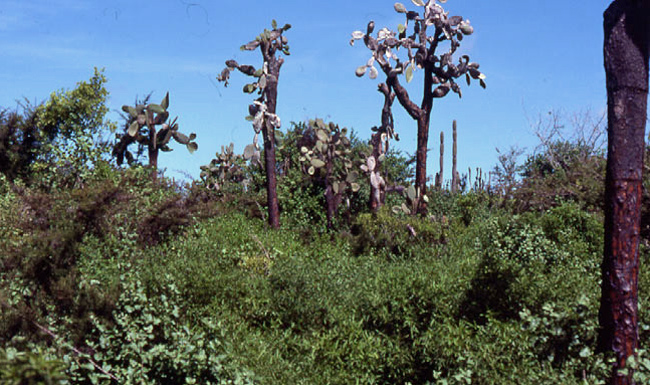
Flora of the Galápagos Islands
Although the indigenous Galápagos flora is smaller in terms of number of species and the endemicity is lower than that in the flora of, for example, the Hawaiian Islands, the Galápagos is still a model archipelago for oceanic islands in that it possesses a disharmonic flora (many plant families missing or poorly represented), a high number of endemic species, and several examples of adaptive radiation. Despite the impact of introduced animals and plants on the indigenous vegetation, only three vascular plant species are believed to be extinct, namely Blutaparon rigidum (Amaranthaceae), Delilia inelegans (Asteraceae) and Sicyos villosa (Cucurbitaceae).
Phytogeographically the Galápagos is strongly allied to the South American mainland from where about 70% of the indigenous flora is derived. Roughly 25% of the flora is pantropical.
The native vascular plant flora comprises 500-560 species (ca 60 species are doubtfully native), ca 180 species are endemic. If introduced and cultivated species are included the total number of species is about 800. The largest families of indigenous vascular plants are
One of the most interesting vascular plant families in the Galápagos is the Amaranthaceae. The family exhibits beautiful examples of adaptive radiation and morphological adaptations to different environmental conditions. From the point of view of conservation it contains endemic taxa representing all categories of threat levels; one species is presumably extinct, several species are threatened to various degrees, some taxa are still common. The genus Lithophila has two (or perhaps three) endemic species in the islands. The sole species outside the archipelago is L. muscoides, a rather polymorphic species restricted to the Caribbean.
Blutaparon rigidum is an endemic species of the Amaranthaceae believed to be extinct. I regard this as one of the most interesting species in the Galápagos flora. It has been collected only twice, in 1891 and in 1905-06, on the northeastern side of the island of Santiago. The species may well have gone extinct due to volcanic activity covering a vast area in this part of the island with lava between 1897 and 1907.
Among the vulnerable or endangered plants of the same family are several species of the genus Alternanthera. Alternanthera nesiotes is restricted to the island of Floreana. It is a prostrate plant with small, 4-8 mm long and often brownish leaves that blend in with the colour of the lava gravel where it grows near the shore. The species has suffered heavily from the browsing of introduced animals (goats and donkeys) in its very restricted distribution area.
The great importance that also very small islets may have for conservation and survival of species is beautifully illustrated by Alternanthera galapagensis. It is an endemic species which seems to be restricted to the islets off the coast of Floreana and has been collected on Caldwell, Enderby and Gardner. It has not been found on the main island of Floreana. This distribution is hard to explain unless assumed that it was once present also on Floreana and was later eradicated there by introduced browsing animals. Islets may sometimes serve as refugia for threatened biota. Protecting and preserving also these small pieces of land should be an important part of the conservation program.
My own research in the Galápagos Islands has mainly focused on the genus Scalesia and on genera of the family Amaranthaceae.
Phytogeographically the Galápagos is strongly allied to the South American mainland from where about 70% of the indigenous flora is derived. Roughly 25% of the flora is pantropical.
The native vascular plant flora comprises 500-560 species (ca 60 species are doubtfully native), ca 180 species are endemic. If introduced and cultivated species are included the total number of species is about 800. The largest families of indigenous vascular plants are
- Asteraceae (35 species/ca 29 endemic)
- Poaceae (34/10)
- Cyperaceae (30/2)
- Amaranthaceae (20/16)
- Euphorbiaceae (17/15)
- Darwiniothamnus, Lecocarpus, Macraea, Scalesia (all in Asteraceae);
- Brachycereus, Jasminocereus (Cactaceae);
- Sicyocaulis (Cucurbitaceae; but the genus is very closely allied to Sicyos)
One of the most interesting vascular plant families in the Galápagos is the Amaranthaceae. The family exhibits beautiful examples of adaptive radiation and morphological adaptations to different environmental conditions. From the point of view of conservation it contains endemic taxa representing all categories of threat levels; one species is presumably extinct, several species are threatened to various degrees, some taxa are still common. The genus Lithophila has two (or perhaps three) endemic species in the islands. The sole species outside the archipelago is L. muscoides, a rather polymorphic species restricted to the Caribbean.
Blutaparon rigidum is an endemic species of the Amaranthaceae believed to be extinct. I regard this as one of the most interesting species in the Galápagos flora. It has been collected only twice, in 1891 and in 1905-06, on the northeastern side of the island of Santiago. The species may well have gone extinct due to volcanic activity covering a vast area in this part of the island with lava between 1897 and 1907.
Among the vulnerable or endangered plants of the same family are several species of the genus Alternanthera. Alternanthera nesiotes is restricted to the island of Floreana. It is a prostrate plant with small, 4-8 mm long and often brownish leaves that blend in with the colour of the lava gravel where it grows near the shore. The species has suffered heavily from the browsing of introduced animals (goats and donkeys) in its very restricted distribution area.
The great importance that also very small islets may have for conservation and survival of species is beautifully illustrated by Alternanthera galapagensis. It is an endemic species which seems to be restricted to the islets off the coast of Floreana and has been collected on Caldwell, Enderby and Gardner. It has not been found on the main island of Floreana. This distribution is hard to explain unless assumed that it was once present also on Floreana and was later eradicated there by introduced browsing animals. Islets may sometimes serve as refugia for threatened biota. Protecting and preserving also these small pieces of land should be an important part of the conservation program.
My own research in the Galápagos Islands has mainly focused on the genus Scalesia and on genera of the family Amaranthaceae.
Selected publications:
Eliasson, U. H.: The evolutionary patterns of the plant family Amaranthaceae on the Galápagos and
Hawaiian Islands. - Journal of the Torrey Botanical Society 131: 105-109 (2004).
Eliasson, U. H.: Species of Amaranthaceae in the Galápagos Islands and their affinities to species on the South American mainland. - In Lawesson, J. E., Hamann, O., Rogers, G., Reck, G. & Ochoa, H. (eds.), Botanical Research and Management in Galápagos. Monographs in Systematic Botany from the Missouri Botanical Garden 32: 29-33 (1990).
Eliasson, U. H.: Identity and taxonomic affinity of some members of the Amaranthaceae from the Galápagos Islands. - Botanical Journal of the Linnean Society (London) 91: 415-433 (1985).
Eliasson, U. H.: Chromosome number of Macraea laricifolia Hooker fil. (Compositae) and its bearing on the taxonomic affinity of the genus. - Botanical Journal of the Linnean Society (London) 88: 253-256 (1984).
Eliasson, U.: Native climax forests /in the Galápagos Islands/. - In Perry, R. (ed.), Galápagos. Pp 101-114. Key Environments Series. Pergamon Press, Oxford (1984).
Eliasson, U.: Studies in Galápagos Plants. XII. On the vegetation of Fernandina before the eruption in 1968. - Botaniska Notiser 125: 49-61 (1972).
Eliasson, U.: The families Aizoaceae (pp 182-184), Amaranthaceae (184-207), Basellaceae (208), Batidaceae (208-209), Chenopodiaceae (210-214), Molluginaceae (217-222), Nyctaginaceae (222-228), Phytolaccaceae (229-231), Caryophyllaceae (541-551), Portulacaceae (728-733) in the Galápagos archipelago. - In Wiggins, I. L. & Porter, D. M., Flora of the Galápagos Islands. Stanford University Press, Stanford (1971).
Eliasson, U.: Studies in Galápagos Plants. VII. On some new or otherwise noteworthy plants from the archipelago.- Botaniska Notiser 121: 630-640 (1969) (Part 4 of vol. 121 was distributed in Jan 1969).
Eliasson, U. H.: Species of Amaranthaceae in the Galápagos Islands and their affinities to species on the South American mainland. - In Lawesson, J. E., Hamann, O., Rogers, G., Reck, G. & Ochoa, H. (eds.), Botanical Research and Management in Galápagos. Monographs in Systematic Botany from the Missouri Botanical Garden 32: 29-33 (1990).
Eliasson, U. H.: Identity and taxonomic affinity of some members of the Amaranthaceae from the Galápagos Islands. - Botanical Journal of the Linnean Society (London) 91: 415-433 (1985).
Eliasson, U. H.: Chromosome number of Macraea laricifolia Hooker fil. (Compositae) and its bearing on the taxonomic affinity of the genus. - Botanical Journal of the Linnean Society (London) 88: 253-256 (1984).
Eliasson, U.: Native climax forests /in the Galápagos Islands/. - In Perry, R. (ed.), Galápagos. Pp 101-114. Key Environments Series. Pergamon Press, Oxford (1984).
Eliasson, U.: Studies in Galápagos Plants. XII. On the vegetation of Fernandina before the eruption in 1968. - Botaniska Notiser 125: 49-61 (1972).
Eliasson, U.: The families Aizoaceae (pp 182-184), Amaranthaceae (184-207), Basellaceae (208), Batidaceae (208-209), Chenopodiaceae (210-214), Molluginaceae (217-222), Nyctaginaceae (222-228), Phytolaccaceae (229-231), Caryophyllaceae (541-551), Portulacaceae (728-733) in the Galápagos archipelago. - In Wiggins, I. L. & Porter, D. M., Flora of the Galápagos Islands. Stanford University Press, Stanford (1971).
Eliasson, U.: Studies in Galápagos Plants. VII. On some new or otherwise noteworthy plants from the archipelago.- Botaniska Notiser 121: 630-640 (1969) (Part 4 of vol. 121 was distributed in Jan 1969).
UNO ELIASSON

University affiliation:
University of Gothenburg
Department of Biological and Environmental Sciences
Email:
uno.botan@gmail.com
Scientific publications:
Click here (pdf) >>